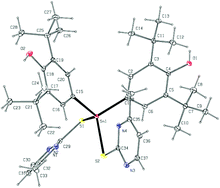Four new organotin(IV) complexes of bis-(2,6-di-tert-butylphenol)tin(IV) dichloride [(tert-Bu-)2(HO-Ph)]2SnCl2 (1) with the heterocyclic thioamides 2-mercapto-pyrimidine (PMTH), 2-mercapto-4-methyl-pyrimidine (MPMTH), 2-mercapto-pyridine (PYTH) and 2-mercapto-benzothiazole (MBZTH), of formulae {[(tert-Bu-)2(HO-Ph)]2Sn(PMT)2} (2), {[(tert-Bu-)2(HO-Ph)]2Sn(MPMT)2} (3), {[(tert-Bu-)2(HO-Ph)]2SnCl(PYT)} (4) and {[(tert-Bu-)2(HO-Ph)]2SnCl(MBZT)} (5), have been synthesized and characterized by elemental analysis, 1H-, 13C-, 119Sn-NMR, EPR, FT-IR, Raman and Mössbauer spectroscopic techniques. The crystal and molecular structures of compounds 1–5 have been determined by X-ray diffraction. The geometries around the metal center adopted in complexes 1–5 varied between tetrahedral in 1, trigonal bipyramidal in 3, 4, 5 and distorted octahedral in 2. Two carbon atoms from aryl groups and two chlorine atoms form a distorted tetrahedron in the case of 1. Two carbon, two sulfur and two nitrogen atoms from thione ligands form a distorted octahedral geometry around tin(IV) with trans-C2, cis-N2, cis-S2-configurations in 2. However, in the case of 4 and 5 complexes two carbon, one sulfur, one nitrogen and one chloride atom form a distorted trigonal bipyramidal arrangement. Finally, in the case of 3 the trigonal bipyramidal geometry is achieved by two carbon, two sulfur and one nitrogen atom in a unique coordination mode of thioamides toward the tin(IV) cation. Compounds 1–5 were tested for their in vitro cytotoxicity against the human breast adenocarcinoma (MCF-7) cell line. Compound 3 exhibits strong cytotoxic activity against MCF-7 cells (IC50 = 0.58 ± 0.1 μM).


 Please wait while we load your content...
Please wait while we load your content...